Gunung Padang Megalithic Site
Gunung Padang, a megalithic site at Karyamukti, Campaka (id) village, is located 6 kilometres (3.7 mi) south of Lampegan railway station and 30 kilometres (19 mi) southwest of Cianjur regency in West Java Province of Indonesia. It has been claimed as the largest megalithic site in Southeastern Asia. Controversial carbon dating results from the site suggest it was built in four different eras, first being claimed as far back as 20,000 BCE.[1] Archaeologist Harry Truman Simanjuntak suggests that the site may have been built much more recently, perhaps sometime between the 2nd and 6th centuries CE.[2] 29 hectares (72 acres) site has been designated as the "National Site Area" by the Ministry of Education and Culture.[3][4]
| Gunung Padang Megalithic Site | |
|---|---|
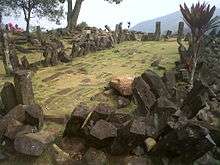 Top of Gunung Padang site | |
| Location | Karyamukti, Cianjur regency, West Java. |
| Coordinates | |
| Built | Built by Sunda Kingdom 7th-16th century during the reign of the King Siliwangi |
| Architect | unknown |
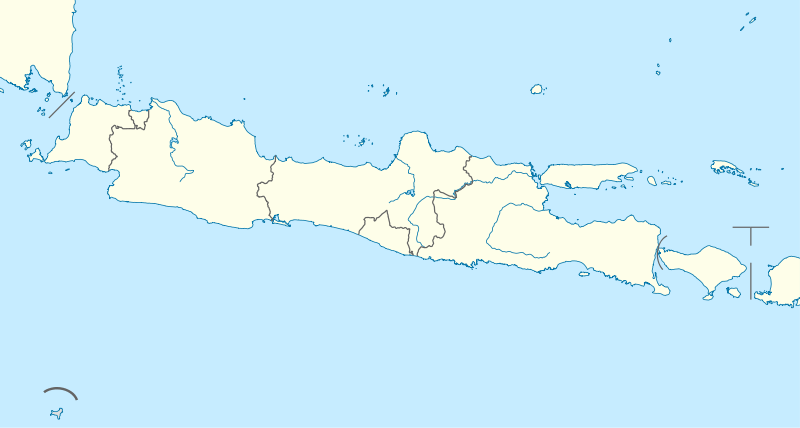 Location within Java 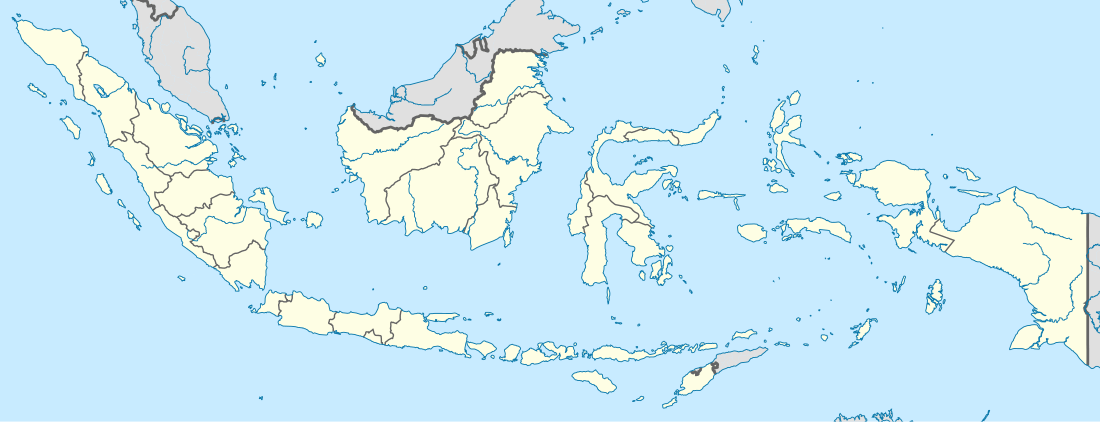 Gunung Padang Megalithic Site (Indonesia) | |
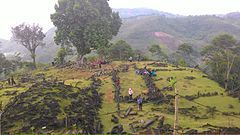
It is located 160 kilometres (99 mi) southeast of Jakarta (Soekarno–Hatta International Airport), 50 kilometres (31 mi) south of Mount Gede Pangrango National Park, 23 kilometres (14 mi) southeast of Sukabumi, and 95 kilometres (59 mi) southwest of popular hill station resort town of Bandung (Husein Sastranegara International Airport). The site can be accessed by two routes: from Sukabumi via Indonesian National Route 3 (NR3) and right turn on to Jalan Cimunkang/Gandaoli, from Cianjur via NR3 and then left turn on to Jalan Raya Sukabumi.[5]
Base of the mountain has a ticket office, restaurant, public bath with water from the natural springs, top of mountain has a wood and steel tower to take the pictures from top.[6][3] "Empang Gunung Padang" dam lies on slope 1 km south of the site and Sundaland tourist village lies 1 km east of the site.
Site, as part of Nusantara (Maritime Southeast Asia),[3] has also been compared to the larger Nan Madol site for similar valconic columns, to Machu Picchu in Peru for having similar terraces on mountain slope,[7][8] and to Borobudur for this site being larger in size than Borobudur.[6] It is also counted among the 5 known terraced monolithic pyramids in Indonesia, all of which are Hindu sites built during Hindu-Buddhist era, other being Candi Kethek, Lebak Cibedug Temple, Pugung Raharjo and Candi Sukuh.[9]
History
.jpg)

Ancient sacred site
"Gunung Padang" (Mount Gunung) can be translated as "Mount Meadow", "Mountain of light" or "Mountain of enlightenment" in Javanese language.[3] Since the prismatic terraces made of basalt logs on the slope of this Gunung Padang face towards the Mount Gede, it has been suggested that for prehsitory humans it was a viewing platform for viewing the more important and sacred mount Mount Gede volcano.[6] Andrew Collins suggests it was a viewing platform for stars.[6]
The Sundanese people consider the site sacred and believe it was the result of King Siliwangi's attempt to build a palace in one night. The asymmetric step pyramid faces northwest, to Mount Gede[10] and was constructed for the purpose of worship.[3] Presently, locals treat tgus as a sacred place of pilgrimage, they visit this site accompanied by "Jura Kunchi" (Key Master or Caretaker) for rituals. They first purify themselves at a natural spring at the base of the mountain before undertaking the climb.[3]
Rediscovery
The existence of the site was mentioned in Rapporten van de Oudheidkundige Dienst (ROD, "Report of the Department of Antiquities") in 1914.[3] The Dutch historian N. J. Krom also mentioned it in 1949.[11] Local farmers rediscovered it in 1979.[3] Consequently, employees of the National Archaeological Research Centre visited the site in 1979 for a study of its archaeology, history, and geology.[11]
Site study
Site geography
The site is located 885 metres (2,904 ft) above sea level on 110 metres (360 ft) tall "Gunung Padang" Hill, itself a mouth of an extinct volcano, composed of andesite igneous rocks which cooled in the shape of tighly packed polygonal vertical columns similar to Giant's Causeway in Ireland.[3] Naturally and uniformly formed crystallised basalt columns formed in the volcanic pipe before the mouth of volcano collapsed.[6] Naturally formed stone columns at Gunung Padang are of square or polygonal shape, 25-40 cms (10 to 16 inch) in height and width, and on average 1.5 meter long with average weight of 250 kg.[6] Andesite columns give out the musical sounds when knocked by knuckles by visitors.[3]
The site, covered with large rectangular stones of volcanic origin, covers a hill in a series of terraces bordered by retaining walls of stone that are accessed by about 400 successive andesite steps on north side rising about 95 metres (312 ft).[10] Researchers have concluded that these naturally formed in situ andesite igneous columns, which occur only in vertical position,[1] have been rearranged by humans to create the structures including laying the columns horizontally to create terraces and other structures.[6][1] South side has 5 stone terraces, east side has 100 stone terraces with width and height of 2 by 2 metres (6 ft 7 in × 6 ft 7 in), west side has stone terraces which are still covered by soil and bush in 2014, and north side has a 1.5 metre-wide staircase and terraces.[7][8][12]
Scientific research
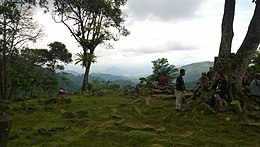
There is consensus among scientists that the upper part of Gunung Padang is "the largest megalithic structure in south-east Asia", it is not a man made pyramid,[1][6] and human structures at the site are less than 3000 years old.[13] Only exploratory research has been done, that too by Indonesian geologist Danny Hilman Natawidjaja (Hilman), and not by the archaeologists and volcanologists.[1]
Site survey
In 2012 and in 2014 after the backing from the President of Indonesia, Indonesian geologist Hilman (Danny Hilman Natawidjaja) of Indonesian Centre for Geotechnical Research conducted site surveys using goelectric, georadar, geomagnetic testing and radiocarbon dating.[14][13] He reported large manmade constructions at site below the surface spanning four eras and found several man-made artifacts,[14][6] including unexcavated likely manmade 5.5x13.7x9.1 meter rectiliniar chambers at 21–27 meters depth, additionally 3 more layers of large manmade chambers at depts of 15 metres (49 ft), 8–10 metres and 12,500 BP (before present), 3–4 metres and 6,500 BP, as well as found artifacts at the surface dating to about 4,800 years BP.[7][8][13] He claims around 10,000 years ago (10 kya) or possibly back to 20,000 BCE the modifications to hill began, around 9,000 years ago humans wrapped its slopes in andesite columns, around 7,000 years ago (7 kya) site was renovated once more and they added parallel layers of stone columns, around 3,000 years ago (3 kya) a new group covered the structure in soil.[12] Goelectric survey by Hilman in 2013, showed presence of chambers below the surface atop the hill and manmade stone structures with horizontally placed columns.[6] Carbon dating of glue or cement between columns in the core drilling samples taken by Hilman, which he claims is not a natural material based on chemical analysis, yielded 13,000 to 23,000 old.[6] He claim to have found manmade articles when holes were dug through some of the chambers, which yielded radiocarbon date of 6500 BC.[6]
American Natural Scientist, Robert M. Schoch, who studied the site, reported that the human history of the site began in 14,700 BC before the end of Last Glacial Period in 9700 BC.[13] He found collapsed structure at the depth of 4–10 meters below the surface dating back to 10,000-9,500 BC, which overlaps with the tumultuous end of ice age when rapid global warming, widespread wild fires, heavy torrential rains and catastrophes raged the surface of earth significantly affacting this site, Göbekli Tepe and others.[13]
Criticism

Several Indonesian archaeologists contest the views of Hilman,[13] they assert that the site is less than 3000 years old,[13] and naturally formed vertical columns can be arranged by humans into low horizontal walls.[6] Hilman agrees that the magaliths on the surface of site may have been arranged less than 3000 years ago, however it was done so to recognise the site as sacred and the human history of site is 12,000 to 20,000 years old.[13] The team of Geologist Hilman and a former activist turned politician Arif, as well as the Hilman's excavations, has been criticized.[1][12] Hilman claims most of this 100 metre hill is man-made, built up in four different cultures of deifferernt eras.[1][7][13] Thirty-four Indonesian scientists, who agree that the upper part of Gunung Padang is "the largest megalithic structure in south-east Asia", signed a petition questioning the motives and methods of the Hilman-Arif team, their wrong assumptions and conclusions.[1][6] While experessing concern regarding Hilman's activity being "carried out without scientific norms of conservation knowledge" which threatens the preservation of the existing site, they asked for archaeologists, not geologists [like Hilman], to conduct the research.[1] Indonesian volcanologist, Sutikno Bronto, also refuted Hilman's claims: "Danny Hilman is not a vulcanologist. I am", the site is the neck of an ancient volcano, not a pyramid, and carbon-dated cement between the stones is just simply the byproduct of a natural weathering process, "not man-made".[6][1] American author, David Hatcher Childress, also wonders that the chambers could be naturally formed, the glue or cement could have been random organic material instead of manmade material, stones on site have no inscriptions, decorations, marks tools or chisels marks.[6]
An archaeologist, who did not wish to be named due to the involvement of the country's president who had set up a task force, refuted Hilman's claims: "In the Pawon cave in Padalarang [about 45 kilometres from Gunung Padang], we found some human bones and tools made of bones about 9500 years ago, or about 7000 BCE. So, if at 7000 BCE our technology was only producing tools of bones, how can people from 20,000 BCE obtain the technology to build a pyramid. In archaeology we usually find the 'culture' first … Then, after we find out the artefact's age we'll seek out historical references to any civilisation which existed around that period. Only then will we be able to explain the artefact historically. In this case, they 'found' something, carbon-dated it, then it looks like they created a civilisation around the period to explain their finding.".[1]
Conservation
After the 2014 survey, Hilman and his team confirmed core zone site area and recommended a plan for the renovation, conservation and management of the site.[14][6] However, little or no significant conservation work has been undertaken.
See also
- Pyramid temples in Indonesia
- Candi Kethek, 5 terraces
- Lebak Cibedug, 9 terraces
- Pugung Raharjo, 5 terraces
- Candi Sukuh, 3 terraces
- Related topics in Java
- Candi Ceto
- Candi of Indonesia
- Prambanan Temple, 6th-9th century UNESCO heritage Hindu temple in Central Java.
- Sunda Kingdom, 7th-16th century Indianised Hindu kingdom in Western and Central Java.
- Taruma Kingdom, 2nd-6th century Indianised Hindu kingdom of Western Java.
- Other related topics
References
- Bachelard, Michael (2013-07-27). Digging for the truth at controversial megalithic site. Sydney Morning Herald, 27 July 2013. Retrieved from http://www.smh.com.au/world/digging-for-the-truth-at-controversial-megalithic-site-20130726-2qphb.html.
- Utomo, Yunanto Wiji (2014-06-06). "Mari Terbang ke Atas Situs Megalitikum Gunung Padang".
- J. Douglas Kenyon, Rising 104 , March/April 2014.
- "Balai Pengelolaan Situs Gunung Padang Segera Dibentuk". 2014-06-25.
- Google (29 July 2020). "Gunung Padang Megalithic Site" (Map). Google Maps. Google. Retrieved 29 July 2020.
- David Hatcher Childress, 2017, The Lost World of Cham: The Transpacific Voyages of the Champe.
- "Laporan Resmi: Situs Gunung Padang Punya 100 Undakan dan Luasnya 25 Hektar". June 27, 2012.
- "Tim Terpadu Riset Mandiri: Gunung Padang Truly Extraordinary". June 28, 2012.
- Flame Rozario, Pyramids in Indonesia? It's not just Gunung Padang 30 May 2016.
- "From Lampegan to Mount Padang". Pikiran-rakyat.com. Retrieved 2013-07-19.
- The Site of Gunung Padang, The Largest Staircase in Southeast Asia, Nusa Daily, 2020.
- Dipa, Arya (2014-09-24). "Archaeologists slam excavation of Gunung Padang site". thejakartapost.com.
- Graham Hancock, 2015, Magicians of the Gods: The Forgotten Wisdom of Earth's Lost Civilisation, Hodder and Stoguhton, UK.
- "Timnas Gunung Padang Hentikan Penelitian". 2014-10-01.
External links
| Wikimedia Commons has media related to Gunung Padang Megalithic Site. |